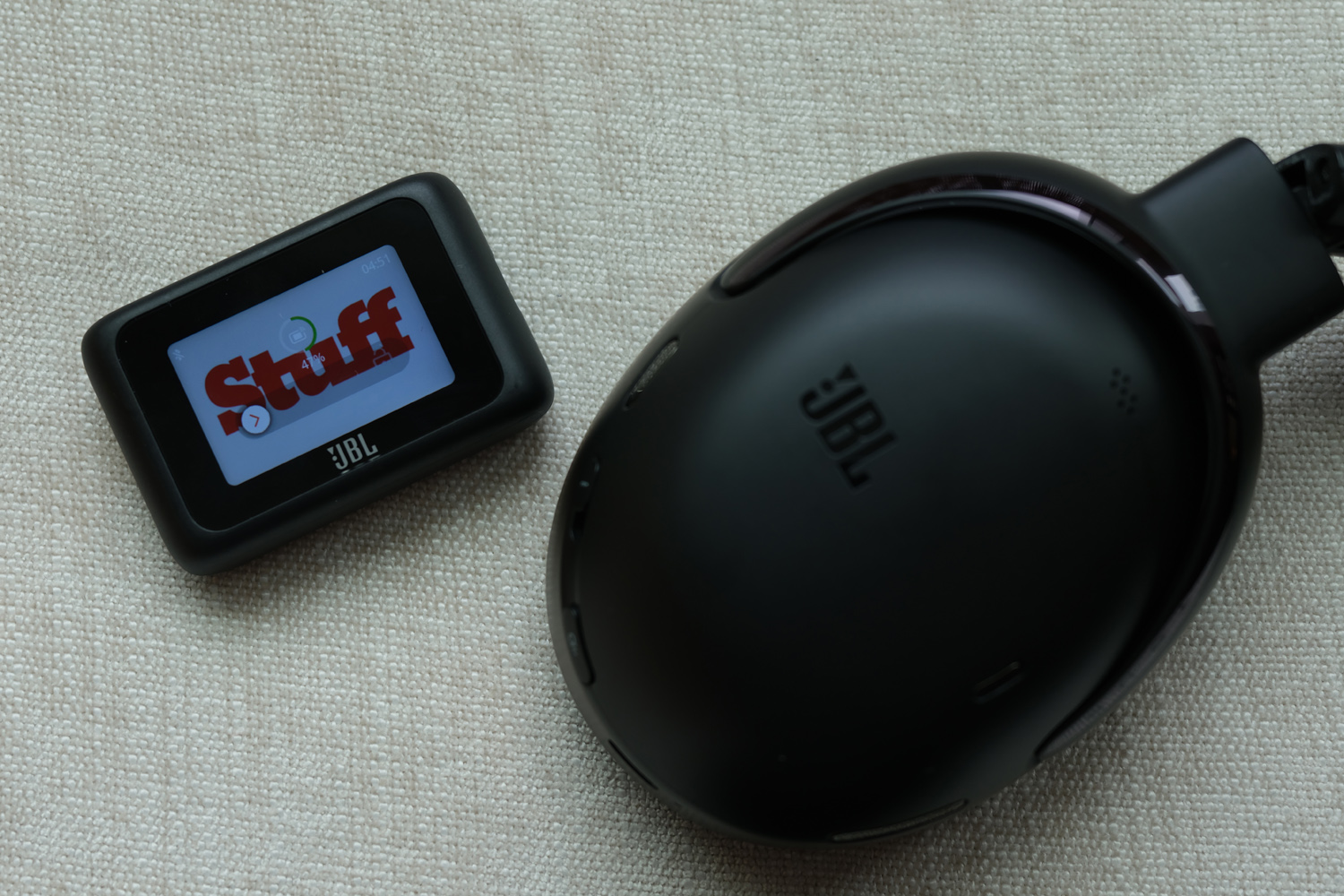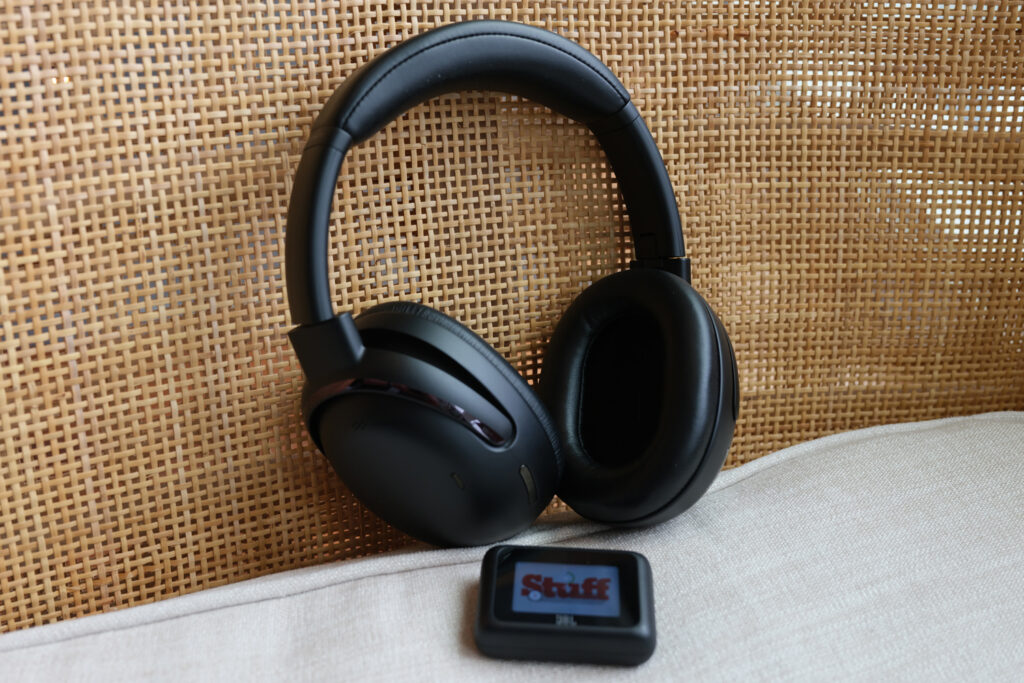Introduction
By taking the best bit from its Tour Pro 3 true wireless earbuds – namely the Tricorder-like charging case – JBL has turned the Tour One M3 into one seriously clever pair of cans. This is the first pair of noise cancelling headphones to come with a separate screen, but there’s more to it than simply giving you another way to control playback.
The Smart Tx is one part wireless transmitter and one part wired DAC, letting you listen to just about anything – whether it has Bluetooth built-in or not. It promises to elevate what’s already a flagship-grade pair of headphones in every other sense, with spatial sound, lossless playback over USB, and hi-res wireless listening all on-board. Auracast transmission ensures the Tour One M3 is future-proof, too.
A feature list so extensive doesn’t come cheap, though. At $400/£380, the headphones and Smart Tx combo are going head-to-head with noise cancelling champs like the Bose QuietComfort Ultra headphones and sound specialists such as the Bowers & Wilkins Px7 S2e. Are the extras just gimmicks, or do they make the JBL Tour One M3 a compelling all-rounder?
Design & build: smarter than they look
If you equate weight with luxury, you might be initially underwhelmed by the JBL Tour One M3. Metal headband aside, the whole thing is made from plastic. Being so light makes them very comfortable to wear for long listening sessions, though. The clamping force is well-judged and the ear cushions have plenty of padding.
There’s enough tilt, swivel and headband adjustment here to suit all head shapes and sizes, and they fold neatly away for travel. The included hard shell carry case also has a pouch for the various cables, and a pocket to stow the Smart Tx transmitter. The carry strap and carabiner clip for hooking onto your luggage is a nice touch.
These aren’t the flashiest looking headphones, with a design that hasn’t strayed too far from the previous generation. The matte finish, subtle branding and colour-matched trim in now way scream “these cost me $400”. Which is great if you like the subtle approach; if you want your tech to make a statement, the Latte or Blue versions have more presence than my black review sample.
On-ear controls are fairly sparse, with just a power/pairing slider, ANC toggle and volume buttons. Touch gestures are built into the right ear cup to skip tunes or answer incoming calls. It’s super-sensitive, so accidental pauses were common. The only wired connection is USB-C; JBL has stripped out the 3.5mm analogue input found on the outgoing Tour One M2. The Smart Tx can act as a stand-in, but seeing how the Tour One M3 is also sold solo, it makes sense that you get a USB-C-to-3.5mm cable in the box for listening directly to your non-wireless kit. It can do digital playback over USB-C too, and you get a USB-A-to-USB-C adapter if your gear doesn’t have a USB connection.
Features & battery: tonal Tricorder

The Smart Tx is easily the JBL Tour One M3’s USP; it looks a bit like a pager, had smartphones not driven them to extinction in the 2000s. It’s no bigger than a pack of TicTacs, with smooth edges for sliding easily in and out of your pocket. There’s just one button up top for waking it; everything else is handled through the touchscreen.
The interface is essentially identical to the one built into the Tour Pro 3 earphones’ charging case. You can swipe through the different tabs to swap EQ presets, adjust the noise cancellation, activate spatial audio, and control music playback without reaching for your phone. ID3 tags show what’s playing, but album art and a playback scrubber are MIA.
I like that you can disable any pages you don’t find useful, as the sheer number of them can be overwhelming. Connection status, battery life and the current time are shown on the lock screen, which can be customised with your own background photo.
Being able to display new messages and notifications is a big win, as is accepting or rejecting incoming calls. I can’t say I found much use for the flashlight function (which just blasts a white screen at full brightness) but the timer came in handy a few times when my phone was out of reach. That said, how often are you listening to your phone without it being nearby? I would also sometimes forget I had the Smart Tx on me, so would instinctively grab my phone instead.
There’s another reason to want this practical little puck, though. A USB-C port at either end lets it act as a Bluetooth broadcaster, so it can stay tethered to your inflight entertainment while you roam the cabin, and becomes a pocket-sized DAC for hi-res streaming from your wired audio kit. Auracast transmission means it can share sound with any compatible headphones, not just JBL ones, and it works both ways; the transmitter can pick up Auracast broadcasts and beam them to the headphones.
It’s all pretty seamless. Plug in the right cable (3.5mm and USB-C are both in the box, along with a sturdy carry case) and the headphones switch sources automatically. I do wish it was easier to swap between sources, though: I had to unplug the USB connection to get to swap back to my headphones for when I wanted to leave my seat and stretch my legs. And if you’re not a frequent flyer, you might not use half of the Smart Tx’s functionality.
The headphones themselves have Bluetooth 5.3 on-board, along with Multipoint and Google Fast Pair. The connection was stable throughout my testing, even in a crowded airport. It made a great travel companion thanks to an extensive 70-hour (40 hours with ANC) battery life: it lasted both legs of an international trip without needing to recharge once. That’s better than most rivals in this price range. The Smart Tx went flat before my second flight touched down, though, as it can only handle 18 hours of broadcasting.
Interface: not short on stuff
JBL’s smartphone companion app is somehow even more packed with goodies than the Smart Tx. The firm’s Personi-fi personalised listening mode tests your hearing and adapts the audio accordingly; there’s a 12-band custom EQ, personal sound amplification to make nearby voices easier to hear, and spatial audio upmixing with head tracking. I can take or leave that last one, personally, but I know others are big fans of the exaggerated surround effects.
A few functions can only be activated from the app, rather than the Smart Tx. That includes the relaxing white noise generator, left/right sound balance, and maximum volume limiter. Customising the headphones’ gesture controls is done here too, but you’re only offered one or two presets instead of given free reign to set up different taps.
It’s a shame that JBL locks off a lot of the audio-related settings if you enable LDAC Bluetooth; you’ve got to step down to the more basic SBC if you want spatial sound and the like.
Sound quality and noise cancelling: packs a punch
With 40mm dynamic drivers delivering ample amounts of low-end oomph using the standard preset, the Tour One M3 sticks closely to JBL’s familiar energetic tuning curve. They are a fun and easy listen, not an analytical one; if you want maximum precision or clarity there are better alternatives at this price.
Still, the depth of the squelchy sub-bass on Friction’s Set Me Free put a big smile on my face, and they held up well as I increased the volume. Vocal and acoustic tracks did highlight a weakness in the high-end, but it was one I quickly dialled out with some custom EQ tweaks to the treble frequencies. This brought back some of the bite and attack to Burial’s Phoneglow. Being able to swap presets quickly using the Smart Tx was very handy when bouncing between music, movies, podcasts and games on a flight.
This was also where the JBL Tour One M3’s active noise cancelling came into its own. The adaptive mode kept the engine drone at bay to a level I wasn’t expecting, and background chatter on public transport was handled very well too. While I still give the gold medal to Bose, you now have to count JBL among the upper echelons of ANC headphones.
JBL Tour One M3 verdict
Had JBL sent me the Tour One M3 by themselves, without the Smart Tx transmitter, I still would’ve been impressed by their noise cancelling ability, comfort, and wired connectivity. The price puts them up against established rivals that either offer slightly better noise cancelling or more nuanced audio, and not everyone will appreciate the plain, plastic-heavy build – but the substantial battery life and folding design tick lots of boxes.
Factoring in that smart little screen, anyone with ample air miles will appreciate the wireless flexibility the Smart Tx brings. Few would call it essential, but for a certain crowd it’ll be well worth the price premium.
JBL Tour One M3 technical specifications
| Drivers | 40mm dynamic |
| ANC | Yes, adaptive |
| Bluetooth version | Bluetooth 5.3 |
| Codecs supported | SBC, AAC, LC3, LDAC, Auracast |
| Battery life | Up to 40 hours (ANC on), up to 70 hours (ANC off) 18 hours (Smart Tx) |
| Weight | 278g (headphones), 35g (Smart Tx) |
Read the full article here
